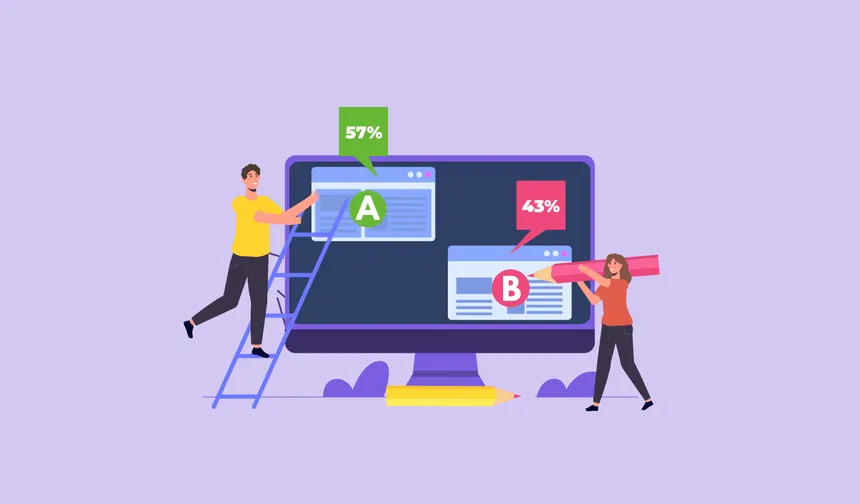22 Jun, 2024 • 9 min read
7 A/B Testing Examples to Bookmark

You’re about to discover seven A/B testing examples that drive real results, but first, let’s get one thing straight: understanding statistical significance is key to separating winners from losers. You’ll want to calculate it in Excel using formulas like AVERAGE, STDEV, and T.TEST, or utilize a free calculator to simplify the process. But what is statistical significance, and why is it essential for data-driven decisions? As you explore these questions, you’ll uncover the importance of Bayesian statistics and different approaches to calculating significance. Get ready to uncover the secrets to making informed decisions and driving business growth through A/B testing.
Contents
- 1 How to calculate statistical significance in excel sheet with A/B testing formulas?
- 2 The ‘what’, ‘why’ and ‘how’ of statistical significance
- 3 Free Excel & Google Sheets A/B Statistical Significance Calculator
- 4 What is Statistical Significance?
- 5 Why is Statistical Significance Important?
- 6 How to Build Your Own Calculator in Excel
- 7 What is statistical significance?
- 8 Why do we use Bayesian statistics?
- 9 Different approaches to calculate statistical significance
How to calculate statistical significance in excel sheet with A/B testing formulas?
Calculating Statistical Significance in Excel for A/B Testing
To calculate statistical significance in an Excel sheet for A/B testing, use formulas to find out if the difference between the control and variation groups is real or just a coincidence.
What You Need:
- Number of visitors for both groups
- Number of conversions for both groups
What Excel Does:
- Uses AVERAGE, STDEV, and T.TEST functions to perform statistical analysis
- Computes significance, p-value, z-value, and other important metrics automatically
Understanding the Results:
- A lower p-value (less than 0.05) means the difference is likely real
- A higher p-value (more than 0.05) means the difference might be just a coincidence
- Use the results to decide if your A/B testing campaign is working or not
Why This Matters:
- Helps you make informed decisions about your A/B testing strategies
- Ensures you don’t waste time and resources on campaigns that don’t work
The ‘what’, ‘why’ and ‘how’ of statistical significance
What is Statistical Significance?
When you do A/B testing, understanding statistical significance is crucial to know if your marketing efforts are really working or just a coincidence. In simple terms, statistical significance measures the probability that the difference between two groups isn’t just luck.
Why is Statistical Significance Important?
The importance of validation can’t be overstated. By ensuring that your results are statistically significant, you can confidently say that the changes you made to your marketing strategy are the reason for the results, not just luck. This has a big impact on decision-making. With statistically significant results, you can make informed decisions about where to allocate resources, optimize campaigns, and drive better outcomes.
How to Achieve Statistical Significance?
To achieve statistical significance, follow these steps:
- Define a clear hypothesis
- Set up a controlled experiment
- Randomly assign participants
- Record results
- Use Excel functions like AVERAGE, STDEV, and T.TEST to calculate the necessary metrics
Free Excel & Google Sheets A/B Statistical Significance Calculator
Simplify A/B Testing with a Free Statistical Significance Calculator
Calculate statistical significance easily with a free A/B test significance calculator, available in both Excel and Google Sheets versions. This calculator helps you input the number of visitors and conversions for both the control and variation groups, and automatically computes the significance, p-value, z-value, and other relevant metrics.
Save Time and Effort with Easy Data Analysis
This calculator is a valuable tool for A/B testing, saving you time and effort in conducting statistical analysis.
You can:
– Easily input your data
– Get instant results
– Make data interpretation a breeze
The calculator takes care of the complex calculations, providing you with a clear picture of your test results.
Make Data-Driven Decisions with Confidence
With this calculator, you can focus on what matters most – making data-driven decisions to optimize your campaigns.
By streamlining the statistical analysis process, you can:
– Quickly identify winning variations
– Make informed decisions to drive better results
Whether you’re a marketer, analyst, or optimizer, this free A/B test significance calculator is an essential tool to have in your arsenal.
What is Statistical Significance?
What is Statistical Significance?
Statistical significance measures the probability that a difference between two groups is real or just a coincidence. For example, in an A/B test, it helps you decide if the results you’re seeing are genuine or just luck.
How Does it Work?
When you run an A/B test, you compare two groups to see if there’s a significant difference between them. Significance testing explains whether this difference is real or just chance.
A Simple Example
Let’s say you’re testing two versions of a landing page, and you find that version A converts 20% better than version B. But is this difference real?
How to Decide
If the p-value is below 0.05, you can conclude that the difference is real and not just due to chance. This gives you the confidence to make informed decisions about which version to use moving forward.
The Benefits
By understanding statistical significance, you can:
- Separate the signal from the noise
- Make data-driven decisions that drive real results
Why is Statistical Significance Important?
Why Statistical Significance Matters
Statistical significance is crucial in A/B testing because it helps you separate real results from chance occurrences. This enables you to make informed decisions that drive business growth.
What Happens Without Statistical Significance?
Without statistical significance, you might invest time and resources into changes that don’t actually improve your business. This can lead to:
- Wasting resources on ineffective changes
- Making decisions based on false information
The Importance of Statistical Power
Understanding statistical power ensures your A/B tests are robust enough to detect meaningful differences between variations. This is especially important when working with smaller sample sizes. A small sample size can lead to:
- False positives (thinking a change is good when it’s not)
- False negatives (thinking a change is bad when it’s good)
Prioritizing Statistical Significance
By prioritizing statistical significance, you can:
- Confidently identify winners and losers
- Make data-driven decisions that drive real growth
- Minimize the risk of wasting resources on ineffective changes
- Maximize the ROI of your A/B testing efforts
How to Build Your Own Calculator in Excel
Create Your Own Calculator in Excel
You’re about to turn your Excel spreadsheet into a powerful calculator for statistical significance. With Excel automation, you’ll analyze data faster and make informed decisions quicker.
Step 1: Define Your Hypothesis
- Clearly state what you want to test.
- Include a null hypothesis.
Step 2: Set Up Your Experiment
- Create two versions of a web page or campaign:
- One for the control group.
- One for the test group.
Step 3: Randomly Assign Participants
- Use Excel’s random number generator function to assign each participant to either the control or test group.
Step 4: Record and Analyze Your Results
- Create a table in Excel to record the number of clicks or conversions for each group.
- Use Excel functions like AVERAGE and STDEV to calculate:
- The mean of the conversion rates for each group.
- The standard deviation of the conversion rates for each group.
What is statistical significance?
What is Statistical Significance?
You’ve probably heard of ‘statistical significance,’ but do you know what it means in A/B testing and marketing campaigns?
Statistical Significance in Simple Terms
Statistical significance is a way to figure out if the results you’re seeing are real or just a coincidence. It helps you decide if the difference between your control group and variation group is important or not.
Why is Statistical Significance Important?
In A/B testing, statistical significance is crucial because it helps you make informed decisions about which campaign to use. Without it, you might waste time and resources on a strategy that doesn’t work.
What Does Statistical Significance Do?
- Helps you identify real patterns and relationships in your data
- Allows you to make data-driven decisions instead of guessing
- Gives you confidence in your results
Calculating Statistical Significance
Want to know how to calculate statistical significance? We’ll explore the details in the next section!
Why do we use Bayesian statistics?
Why Bayesian Statistics?
Bayesian statistics is a way to calculate statistical significance that’s more intuitive and flexible. It lets you use what you already know and update your ideas as new data comes in. This approach is great for A/B testing.
Four Benefits of Bayesian Statistics
- Use what you already know:
Bayesian statistics lets you use what you already know or believe about the experiment, which can give you more accurate results.
2. Be flexible:
Bayesian models can be easily updated as new data comes in, making it great for testing in small steps.
3. Use it in real life:
Bayesian statistics has practical uses in A/B testing, like finding the probability of a winner or how big an effect is.
4. Easy to understand:
Bayesian results are often easier to understand than traditional ways of doing statistics, making it great for people who aren’t experts.
Different approaches to calculate statistical significance
Calculating Statistical Significance: Different Approaches
When calculating statistical significance in A/B testing, you have two main approaches to choose from: frequentist and Bayesian.
Frequentist Approach
The frequentist approach focuses on the probability of observing the results assuming there’s no actual difference between the control and variation groups. However, this method has some limitations:
– It doesn’t take into account prior knowledge or uncertainty.
– It’s not very flexible and can be limited in its application.
Bayesian Approach
The Bayesian approach is different. It incorporates prior knowledge and uncertainty, providing a more in-depth understanding of the results. The benefits of Bayesian statistics include:
– More flexible modeling
– Ability to handle complex data structures
– Takes into account prior knowledge and uncertainty
Statistical Power and Sample Size
Regardless of the approach you choose, it’s crucial to consider two important factors: statistical power and sample size.
- Statistical Power: This refers to the ability to detect a true effect. You want to make sure you have enough power to detect the difference you’re looking for.
- Sample Size: This affects the precision of the results. A larger sample size can increase statistical power, but it also increases the resources required for the test.

Ankur
Ankur, with over 20 years of expertise, simplifies the complex world of online marketing to boost your conversion rates. He shares actionable insights that anyone can apply to see immediate results. Trust Ankur to guide you through proven strategies that enhance your online presence and profitability.
Related Blogs

By Ankur • 9 min read
A/B Testing Significance Calculator Spreadsheet in Excel
You can calculate the statistical significance of your A/B testing results using a spreadsheet in Excel, allowing you to confidently determine whether your variations are...

By Ankur • 8 min read
What Is Multi-Armed Bandit (Mab) Testing? | Feedify
You're using Multi-Armed Bandit (MAB) testing to dynamically allocate traffic to the best-performing versions, maximizing conversions and optimizing metrics, especially in high-traffic scenarios where every...

By Ankur • 7 min read
Click-Through Rate (Ctr) Vs Conversion Rate: Definition, Formula, Calculation
You're looking to understand the difference between Click-Through Rate (CTR) and Conversion Rate, two essential metrics for online advertising campaigns. CTR measures the percentage of...
